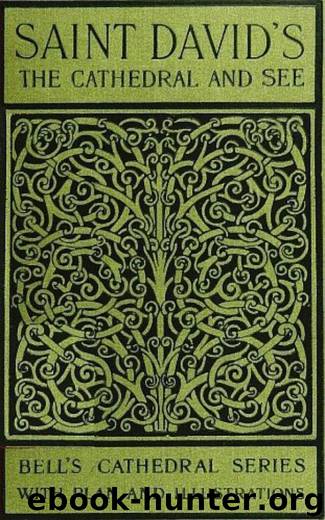Bell's Cathedrals: St. David's by Philip A. Robson

Author:Philip A. Robson [Robson, Philip A.]
Language: eng
Format: epub
Published: 2016-09-06T22:00:00+00:00
THE CHAPELS EAST OF THE PRESBYTERY.
The chapels at the far east end of the church are extraordinarily extensive and most remarkable for a comparatively small cathedral like St. David’s. This being so it is best to refer to the plan, which will simplify what seems bewildering in mere description. Generally speaking the ground-plan may be considered as an extension of the main body of the church, terminating in a Lady Chapel, with aisles continuing those of the choir for part of the length. But, inasmuch as no part of the cathedral seems to have attracted the attention of the various prelates who were successively benefactors to the church, more than this; and, as the changes were numerous and but little regard appears to have been paid to preceding plans, the inevitable result is a kind of architectural pot-pourri. It is, however, a very attractive medley.
De Leiâ’s church clearly terminated at the existing east wall of the presbytery and aisles, and apparently at the time of the rebuilding occasioned by the fall of the tower in 1220, no attempt was made to lengthen the church eastwards. It is not unlikely, however, that shortly before the time of the earthquake of 1248 a Lady Chapel or retro-choir was contemplated and even begun, but discontinued. As we see it now it is also not improbable that the original plan may have been followed, with many changes in detail in the succeeding centuries. The aisles continuing those of the presbytery are connected by a sort of retro-choir or ambulatory—embracing the space now occupied by Bishop Vaughan’s Chapel between it and the east wall of the presbytery. This is all Early English, i.e., thirteenth century, work. Bishop Martyn (1290-1328) completed the present ground-plan by adding his Lady Chapel.
Bishop Gower (1328-1347), the Menevian Wykeham, raised the north and east walls of the north chapel aisle and rebuilt the south and east walls of the south aisle from the ground, probably on Early English foundations. Also, this aisle was projected a few feet in an easterly direction and many changes made in the Lady Chapel, where Gower founded a charity in 1334. Bishop Vaughan (1509-1522) appropriated the space east of the presbytery which was described [59] as “vilissimus sive sordidissimus locus in totâ ecclesiâ,” and converted it into the beautiful chapel which bears his name. Previous to this we can find no early references to this space which was walled in north,
Download
This site does not store any files on its server. We only index and link to content provided by other sites. Please contact the content providers to delete copyright contents if any and email us, we'll remove relevant links or contents immediately.
Kathy Andrews Collection by Kathy Andrews(11730)
The remains of the day by Kazuo Ishiguro(8821)
Paper Towns by Green John(5089)
Spare by Prince Harry The Duke of Sussex(5072)
Industrial Automation from Scratch: A hands-on guide to using sensors, actuators, PLCs, HMIs, and SCADA to automate industrial processes by Olushola Akande(4978)
The Body: A Guide for Occupants by Bill Bryson(4974)
Machine Learning at Scale with H2O by Gregory Keys | David Whiting(4178)
Be in a Treehouse by Pete Nelson(3946)
Never by Ken Follett(3790)
Harry Potter and the Goblet Of Fire by J.K. Rowling(3773)
Goodbye Paradise(3727)
Into Thin Air by Jon Krakauer(3312)
The Remains of the Day by Kazuo Ishiguro(3293)
The Cellar by Natasha Preston(3260)
The Genius of Japanese Carpentry by Azby Brown(3224)
Fairy Tale by Stephen King(3220)
120 Days of Sodom by Marquis de Sade(3179)
The Man Who Died Twice by Richard Osman(2997)
Drawing Shortcuts: Developing Quick Drawing Skills Using Today's Technology by Leggitt Jim(2996)
